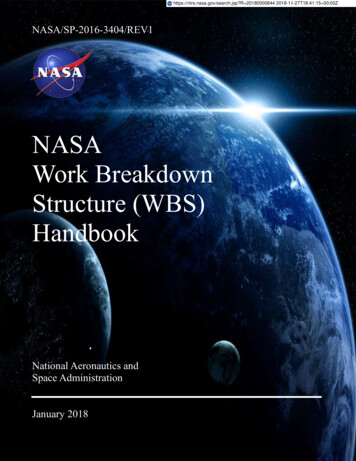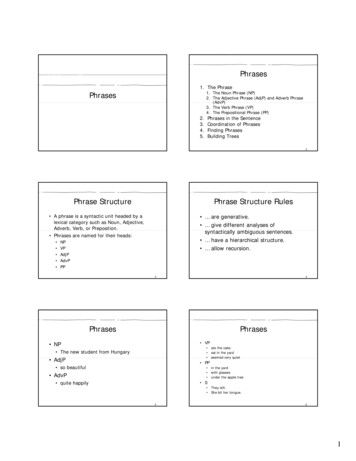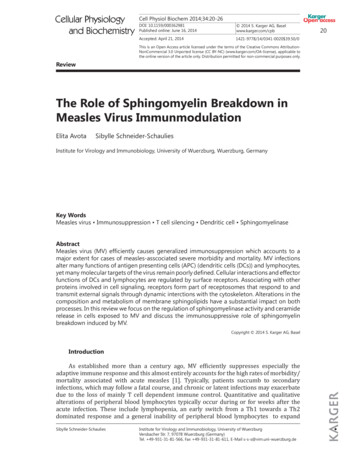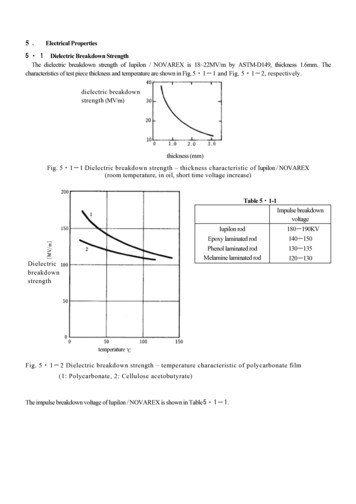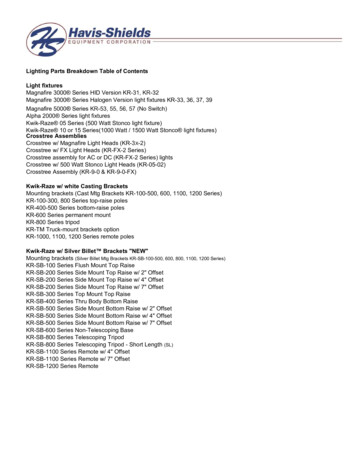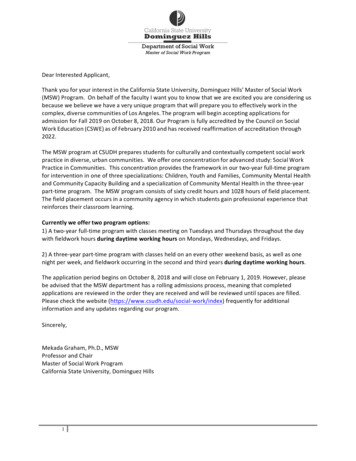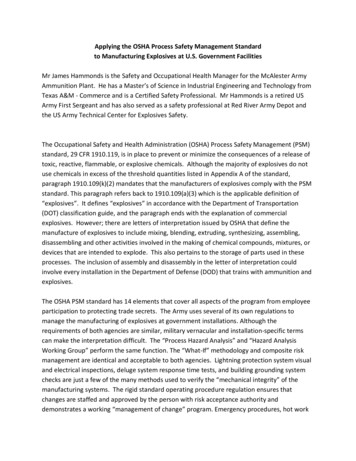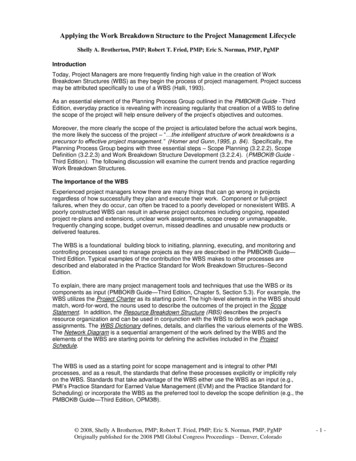
Transcription
Applying the Work Breakdown Structure to the Project Management LifecycleShelly A. Brotherton, PMP; Robert T. Fried, PMP; Eric S. Norman, PMP, PgMPIntroductionToday, Project Managers are more frequently finding high value in the creation of WorkBreakdown Structures (WBS) as they begin the process of project management. Project successmay be attributed specifically to use of a WBS (Halli, 1993).As an essential element of the Planning Process Group outlined in the PMBOK Guide - ThirdEdition, everyday practice is revealing with increasing regularity that creation of a WBS to definethe scope of the project will help ensure delivery of the project’s objectives and outcomes.Moreover, the more clearly the scope of the project is articulated before the actual work begins,the more likely the success of the project – ― the intelligent structure of work breakdowns is aprecursor to effective project management.” (Homer and Gunn,1995, p. 84). Specifically, thePlanning Process Group begins with three essential steps – Scope Planning (3.2.2.2), ScopeDefinition (3.2.2.3) and Work Breakdown Structure Development (3.2.2.4). (PMBOK Guide Third Edition). The following discussion will examine the current trends and practice regardingWork Breakdown Structures.The Importance of the WBSExperienced project managers know there are many things that can go wrong in projectsregardless of how successfully they plan and execute their work. Component or full-projectfailures, when they do occur, can often be traced to a poorly developed or nonexistent WBS. Apoorly constructed WBS can result in adverse project outcomes including ongoing, repeatedproject re-plans and extensions, unclear work assignments, scope creep or unmanageable,frequently changing scope, budget overrun, missed deadlines and unusable new products ordelivered features.The WBS is a foundational building block to initiating, planning, executing, and monitoring andcontrolling processes used to manage projects as they are described in the PMBOK Guide—Third Edition. Typical examples of the contribution the WBS makes to other processes aredescribed and elaborated in the Practice Standard for Work Breakdown Structures–SecondEdition.To explain, there are many project management tools and techniques that use the WBS or itscomponents as input (PMBOK Guide—Third Edition, Chapter 5, Section 5.3). For example, theWBS utilizes the Project Charter as its starting point. The high-level elements in the WBS shouldmatch, word-for-word, the nouns used to describe the outcomes of the project in the ScopeStatement. In addition, the Resource Breakdown Structure (RBS) describes the project’sresource organization and can be used in conjunction with the WBS to define work packageassignments. The WBS Dictionary defines, details, and clarifies the various elements of the WBS.The Network Diagram is a sequential arrangement of the work defined by the WBS and theelements of the WBS are starting points for defining the activities included in the ProjectSchedule.The WBS is used as a starting point for scope management and is integral to other PMIprocesses, and as a result, the standards that define these processes explicitly or implicitly relyon the WBS. Standards that take advantage of the WBS either use the WBS as an input (e.g.,PMI’s Practice Standard for Earned Value Management (EVM) and the Practice Standard forScheduling) or incorporate the WBS as the preferred tool to develop the scope definition (e.g., thePMBOK Guide—Third Edition, OPM3 ). 2008, Shelly A Brotherton, PMP; Robert T. Fried, PMP; Eric S. Norman, PMP, PgMPOriginally published for the 2008 PMI Global Congress Proceedings – Denver, Colorado-1-
WBS ConceptsA WBS, as defined in the PMBOK Guide—Third Edition is ―a deliverable-oriented hierarchicaldecomposition of the work to be executed by the project team to accomplish the projectobjectives and create the required deliverables. It organizes and defines the total scope of theproject. Each descending level represents an increasingly detailed definition of the project work.The WBS is decomposed into work packages. The deliverable orientation of the hierarchyincludes both internal and external deliverables.‖With this definition, it is clear the WBS provides an unambiguous statement of the objectives anddeliverables of the work to be performed. It represents an explicit description of the project’sscope, deliverables and outcomes—the ―what‖ of the project. The WBS is not a description ofthe processes followed to perform the project nor does it address the schedule that defineshow or when the deliverables will be produced, but rather is specifically limited to describing anddetailing the project’s outcomes or scope. The WBS is a foundational project managementcomponent, and as such is a critical input to other project management processes anddeliverables such as activity definitions, project schedule network diagrams, project and programschedules, performance reports, risk analysis and response, control tools or project organization.Defining the WBSThe upper levels of the WBS typically reflect the major deliverable work areas of the project,decomposed into logical groupings of work. The content of the upper levels can vary, dependingon the type of project and industry involved. The lower WBS elements provide appropriate detailand focus for support of project management processes such as schedule development, costestimating, resource allocation, and risk assessment. The lowest-level WBS components arecalled Work Packages and contain the definitions of work to be performed and tracked. Thesecan be later used as input to the scheduling process to support the elaboration of tasks, activities,resources and milestones which can be cost estimated, monitored, and controlled.A few of the key characteristics of high-quality Work Breakdown Structures (Practice Standard forWork Breakdown Structures–Second Edition) are outlined below:A central attribute of the WBS is that it is ―deliverable orientated‖ (Berg and Colenso,2000). The PMBOK Guide—Third Edition defines a deliverable as: ―Any unique andverifiable product, result, or capability to perform a service that must be produced tocomplete a process, phase or project.‖ In this context, ―oriented‖ means aligned orpositioned with respect to deliverables, i.e., focused on deliverables.An additional key attribute of the WBS is that it is a ― hierarchical decomposition of thework ‖ Decomposition is ―a planning technique that subdivides the project scope andproject deliverables into smaller, more manageable components, until the project workassociated with accomplishing the project scope and deliverables is defined in sufficientdetail to support executing, monitoring, and controlling the work‖ (PMBOK Guide—ThirdEdition). This decomposition (or subdivision) clearly and comprehensively defines thescope of the project in terms of individual sub-deliverables that the project participantscan easily understand. The specific number of levels defined and elaborated for aspecific project should be appropriate for effectively managing the work in question.The 100% Rule (Haugan, 2002, p 17) is one of the most important principles guiding thedevelopment, decomposition and evaluation of the WBS. This rule states that the WBSincludes 100% of the work defined by the project scope and, by doing so, captures ALLdeliverables—internal, external and interim—in terms of work to be completed, includingproject management. The rule applies at all levels within the hierarchy: the sum of thework at the ―child‖ level must equal 100% of the work represented by the ―parent‖—andthe WBS should not include any work that falls outside the actual scope of the project;that is, it cannot include more than 100% of the work.The WBS can be represented in a variety of ways including graphical, textual or tabularviews. The form of representation should be chosen based on the needs of the specific 2008, Shelly A Brotherton, PMP; Robert T. Fried, PMP; Eric S. Norman, PMP, PgMPOriginally published for the 2008 PMI Global Congress Proceedings – Denver, Colorado-2-
project. Exhibits 1 through 3 below illustrate the very same WBS elements represented inOutline View format (Exhibit 1), Organization Chart format (Exhibit 2) and in the Tree orCentralized Tree Structure (Exhibit 3):1.0New Product Release1.1 New Product Inventory1.2 Product Documentation1.3 Product Training Materials1.4 Project ManagementExhibit 1 – Outline View.1.0New ProductRelease1.1New ProductInventory1.2ProductDocumentation1.3Product TrainingMaterials1.4Project ManagementExhibit 2 – Tree Structure, or “Organizational Chart” Structure.1.2ProductDocumentation1.1New ProductInventory1.0New ProductRelease1.3Product TrainingMaterials1.4Project ManagementExhibit 3 – Centralized Tree Structure. 2008, Shelly A Brotherton, PMP; Robert T. Fried, PMP; Eric S. Norman, PMP, PgMPOriginally published for the 2008 PMI Global Congress Proceedings – Denver, Colorado-3-
It is clear the WBS is the starting point in the planning process for many other essential projectmanagement processes such as Estimating, Scheduling and Monitoring/Controlling. However,applying the WBS effectively to these processes remains a difficult task for many projectmanagers.Transitioning from the Deliverable-Oriented WBS to the Project ScheduleFrequent complaints about the relevance of deliverable-oriented Work Breakdown Structures areattributed to the absence of clear guidance about the methodology used to apply this scopedefinition to other project processes, tools and tasks.In particular, the lack of helpful information about the processes used to apply deliverableoriented Work Breakdown Structures to project scheduling is seen as the primary obstacleproject managers face when attempting to use deliverable-oriented Work Breakdown Structuresas a basis for scope management and schedule development. The difficulty they encounter making the logical association and transition from WBS to project schedule, drives theirreluctance to adopt the practice. In fact, much of the available documentation (e.g., (Pritchard1998); (Rational Unified ocess/manuals/intro/im diff.htm) for applying WorkBreakdown Structures to project scheduling actually suggests the development of ―task-oriented‖or ―process-oriented‖ Work Breakdown Structures to ease the transition from WBS to projectschedule.Demystifying linkages between the Deliverable-Oriented WBS and Project ScheduleTo correct and counter this confusing instruction, key guidance to assist project managers can be found in the PMBOK Guide—Third Edition, Chapter 6. This chapter, Time Management,contains much of the information required to explain and resolve the deliverable-oriented WBS –to – Project Schedule transition challenge. Though somewhat obscured by other importantconcepts presented in this chapter, the core elements that show the linkage between thedeliverable-oriented WBS and the project schedule are present. The elements, extracted fromthe chapter, that explain the transition include Activity Definition, section 6.1; Activity Sequencing,Section 6.2 and project Schedule Development, section 6.5 are examined in detail and contain,specifically, the fundamental concepts required to simplify the process.Activity Definition (section 6.1) describes the inputs, tools, techniques and outputsnecessary to create the listing of activities that will be performed to produce desiredproject outcomes. The Project Time Management Overview (figure 6-1, page 140) andthe detail found in this section clearly show the Scope Statement, WBS and WBSDictionary as inputs to the Activity Definition process. Tools for development of theActivity List, Milestone List and remaining outputs of the process include Decomposition,Rolling Wave Planning and others. Illustrated simply, this can be described as:InputProcessOutputWBS & WBS Dictionary Decomposition Activity/Milestone ListActivity Sequencing (section 6.2) explains how the project’s activities, milestones andapproved changes are used as inputs to the activity sequencing process, while the toolsfor developing the outputs are described, including the Project Schedule NetworkDiagram, updated Activity and Milestone Lists include various network diagrammingtechniques, such as Precedence Diagramming Method (PDM) and Arrow DiagrammingMethod (ADM). As above, a simplified view would be;InputProcessOutputActivity / Milestone List Network Diagramming Project Schedule Network Diagram 2008, Shelly A Brotherton, PMP; Robert T. Fried, PMP; Eric S. Norman, PMP, PgMPOriginally published for the 2008 PMI Global Congress Proceedings – Denver, Colorado-4-
Schedule Development (section 6.5) describes how these two processes are used toproduce the end objectives of the process – the Project Schedule, Schedule Model,Schedule Baseline and other related schedule components. Here, the chapter explainshow the outputs of the two processes above are incorporated as inputs to the schedulingtools and scheduling methodologies to produce the project schedule. Simplified, this canbe illustrated as:InputProcessOutputActivity List / Network Diagram Scheduling Method/tools Project ScheduleSummarizing the information found in these sections:The core elements that enable the elaboration and development of the Project Schedulebegin with the Scope Statement, WBS and WBS Dictionary.These inputs are taken through a decomposition process to produce the project’s Activityand Milestone Lists.These in turn, are input elements to Network Diagramming that produces the ProjectSchedule Network Diagram and updated Activity / Milestone Lists.Finally, the Project Schedule Network Diagram, Updated Activity and Milestone Lists arethen used as input to the project scheduling tools and methodology to generate theProject Schedule. Illustrated in simplified process-flow form as before, the entireprocess can be
Shelly A. Brotherton, PMP; Robert T. Fried, PMP; Eric S. Norman, PMP, PgMP Introduction Today, Project Managers are more frequently finding high value in the creation of Work
